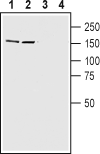Overview
- Peptide (C)DPNFTETIDESKKEWLI, corresponding to amino acid residues 1315-1331 of human Caspr2 (Accession Q9UHC6). Intracellular, C-terminus.
- Rat and mouse brain lysates (1:200).
 Western blot analysis of rat (lanes 1 and 3) and mouse (lanes 2 and 4) brain lysates:1,2. Anti-Caspr2 Antibody (#APZ-005), (1:200).
Western blot analysis of rat (lanes 1 and 3) and mouse (lanes 2 and 4) brain lysates:1,2. Anti-Caspr2 Antibody (#APZ-005), (1:200).
3,4. Anti-Caspr2 Antibody, preincubated with Caspr2 Blocking Peptide (#BLP-PZ005).
- Rat brain frozen sections (1:200).
Contactin-associated protein 2 (Caspr2) is a member of the neurexin superfamily, a group of transmembrane proteins that mediate cell–to-cell interactions in the nervous system1,2.
Neurexins are adhesion molecules expressed mainly at presynaptic locations that form trans-synaptic cell–to-cell adhesion complexes via binding to their postsynaptic partners, the neuroligins2.
Caspr2, like other neurexin proteins, is a type I membrane protein that contains epidermal growth factor repeats, laminin G domains, an F5/8 type C domain, and fibrinogen-like domains in its extracellular domain1,2.
Caspr2 is localized at the juxtaparanodes of myelinated axons, a specialized region that mediates interactions between neurons and glia during nervous system development1.
The juxtaparanodal region is highly enriched with heteromultimers of the K+ channels KV1.1, KV1.2, and their cytoplasmic KVβ2 subunit, which may help in axon conduction stabilization and the maintenance of the internodal resting potential1. Caspr2 is essential for the targeted localization of these channels in the juxtaparanodal regions. Indeed, targeted disruption of Caspr2 resulted in a marked reduction in the accumulation of K+ channels at the juxtaparanodes in both peripheral and central nervous system axons3.
Moreover, mutations in the Caspr2 gene have been implicated in multiple neurodevelopmental disorders, including Tourette syndrome, schizophrenia, epilepsy, autism, attention-deficit hyperactivity disorder and mental retardation4-6.
